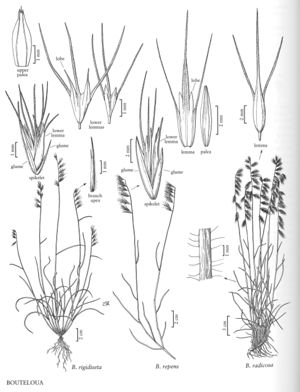Difference between revisions of "Bouteloua radicosa"
FNA>Volume Importer |
FNA>Volume Importer |
||
| Line 17: | Line 17: | ||
-->{{Treatment/Body | -->{{Treatment/Body | ||
|distribution=Maine;Ariz.;N.Mex. | |distribution=Maine;Ariz.;N.Mex. | ||
| − | |discussion=<p>Bouteloua radicosa grows on dry, rocky slopes at 1000-3000 m, from Arizona and southern New Mexico to southern Mexico. It has also become established in Maine, growing in disturbed habtiats, but is not common there.</p><!-- | + | |discussion=<p><i>Bouteloua radicosa</i> grows on dry, rocky slopes at 1000-3000 m, from Arizona and southern New Mexico to southern Mexico. It has also become established in Maine, growing in disturbed habtiats, but is not common there.</p><!-- |
| − | --><p>Bouteloua radicosa frequently grows with B. repens at lower elevations, but extends higher than that species. Like B. repens, B. radicosa exhibits great variation in spikelet and inflorescence characters. Gould (1979) suggested that some of the variation in B. radicosa was due to hybridization with B. repens in the Flora area and B. williamsii Swallen in southern Mexico.</p> | + | --><p><i>Bouteloua radicosa</i> frequently grows with <i>B. repens</i> at lower elevations, but extends higher than that species. Like <i>B. repens</i>, <i>B. radicosa</i> exhibits great variation in spikelet and inflorescence characters. Gould (1979) suggested that some of the variation in <i>B. radicosa</i> was due to hybridization with <i>B. repens</i> in the Flora area and <i>B. williamsii</i> Swallen in southern Mexico.</p> |
|tables= | |tables= | ||
|references= | |references= | ||
| Line 27: | Line 27: | ||
-->{{#Taxon: | -->{{#Taxon: | ||
name=Bouteloua radicosa | name=Bouteloua radicosa | ||
| − | |||
|authority=(E. Fourn.) Griffiths | |authority=(E. Fourn.) Griffiths | ||
|rank=species | |rank=species | ||
| Line 34: | Line 33: | ||
|basionyms= | |basionyms= | ||
|family=Poaceae | |family=Poaceae | ||
| − | |illustrator=Linda A. Vorobik | + | |illustrator=Linda A. Vorobik;Cindy Roché |
| + | |illustration copyright=Utah State University | ||
|distribution=Maine;Ariz.;N.Mex. | |distribution=Maine;Ariz.;N.Mex. | ||
|reference=None | |reference=None | ||
| Line 40: | Line 40: | ||
|publication year= | |publication year= | ||
|special status= | |special status= | ||
| − | |source xml=https:// | + | |source xml=https://jpend@bitbucket.org/aafc-mbb/fna-data-curation.git/src/f50eec43f223ca0e34566be0b046453a0960e173/coarse_grained_fna_xml/V25/V25_880.xml |
|subfamily=Poaceae subfam. Chloridoideae | |subfamily=Poaceae subfam. Chloridoideae | ||
|tribe=Poaceae tribe Cynodonteae | |tribe=Poaceae tribe Cynodonteae | ||
Revision as of 20:38, 16 December 2019
Plants perennial; cespitose, with a dense, hard, knotty base, rhizomatous, rhizomes 2-3 mm thick, with pale cataphylls; internodes 4-5 mm. Culms (40) 60-80 cm, erect, straight, unbranched. Sheaths. strongly striate; ligules 0.5-1 mm, of hairs; blades mostly basal, short and firm, 2-3 mm wide, bases with papillose-based hairs on the margins. Panicles 10-15 cm, usually with 7-12 branches; branches (15)20-30 mm, deciduous, with 8-11 spikelets, apices entire; disarticulation at the base of the branches. Spikelets appressed, all alike, with 2 florets, lowest floret bisexual, upper florets pistillate, bisexual, or staminate. Glumes acuminate, glabrous; lower glumes about 4 mm; upper glumes 5-6 mm; lowest lemmas 7-8 mm, smooth, often shortly trilobed, 3-awned, awns extending from the lobes, central awns 2-3 mm, not flanked by membranous lobes, lateral awns about 1 mm; lower paleas 6-7 mm, unawned, sometimes mucronate; upper lemmas 9-10 mm, central awns 6-8 mm, lateral awns 5-6 mm; upper paleas similar to the lower paleas. Caryopses 4-5 mm long, 0.75-1 mm wide. 2n = 60.
Distribution
Maine, Ariz., N.Mex.
Discussion
Bouteloua radicosa grows on dry, rocky slopes at 1000-3000 m, from Arizona and southern New Mexico to southern Mexico. It has also become established in Maine, growing in disturbed habtiats, but is not common there.
Bouteloua radicosa frequently grows with B. repens at lower elevations, but extends higher than that species. Like B. repens, B. radicosa exhibits great variation in spikelet and inflorescence characters. Gould (1979) suggested that some of the variation in B. radicosa was due to hybridization with B. repens in the Flora area and B. williamsii Swallen in southern Mexico.
Selected References
None.
